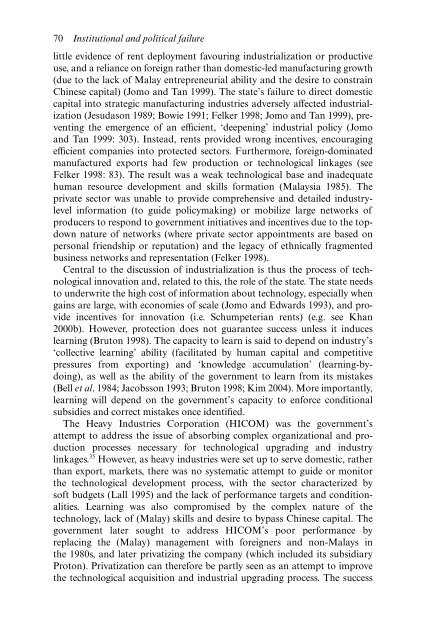PRIVATIZATION Privatization in Malaysia, Regulation, rent-seeking and policy failure
PRIVATIZATION Privatization in Malaysia, Regulation, rent-seeking and policy failure
PRIVATIZATION Privatization in Malaysia, Regulation, rent-seeking and policy failure
Create successful ePaper yourself
Turn your PDF publications into a flip-book with our unique Google optimized e-Paper software.
70 Institutional <strong>and</strong> political <strong>failure</strong>little evidence of <strong>rent</strong> deployment favour<strong>in</strong>g <strong>in</strong>dustrialization or productiveuse, <strong>and</strong> a reliance on foreign rather than domestic-led manufactur<strong>in</strong>g growth(due to the lack of Malay entrepreneurial ability <strong>and</strong> the desire to constra<strong>in</strong>Ch<strong>in</strong>ese capital) (Jomo <strong>and</strong> Tan 1999). The state’s <strong>failure</strong> to direct domesticcapital <strong>in</strong>to strategic manufactur<strong>in</strong>g <strong>in</strong>dustries adversely affected <strong>in</strong>dustrialization(Jesudason 1989; Bowie 1991; Felker 1998; Jomo <strong>and</strong> Tan 1999), prevent<strong>in</strong>gthe emergence of an efficient, ‘deepen<strong>in</strong>g’ <strong>in</strong>dustrial <strong>policy</strong> (Jomo<strong>and</strong> Tan 1999: 303). Instead, <strong>rent</strong>s provided wrong <strong>in</strong>centives, encourag<strong>in</strong>gefficient companies <strong>in</strong>to protected sectors. Furthermore, foreign-dom<strong>in</strong>atedmanufactured exports had few production or technological l<strong>in</strong>kages (seeFelker 1998: 83). The result was a weak technological base <strong>and</strong> <strong>in</strong>adequatehuman resource development <strong>and</strong> skills formation (<strong>Malaysia</strong> 1985). Theprivate sector was unable to provide comprehensive <strong>and</strong> detailed <strong>in</strong>dustrylevel<strong>in</strong>formation (to guide <strong>policy</strong>mak<strong>in</strong>g) or mobilize large networks ofproducers to respond to government <strong>in</strong>itiatives <strong>and</strong> <strong>in</strong>centives due to the topdownnature of networks (where private sector appo<strong>in</strong>tments are based onpersonal friendship or reputation) <strong>and</strong> the legacy of ethnically fragmentedbus<strong>in</strong>ess networks <strong>and</strong> representation (Felker 1998).Central to the discussion of <strong>in</strong>dustrialization is thus the process of technological<strong>in</strong>novation <strong>and</strong>, related to this, the role of the state. The state needsto underwrite the high cost of <strong>in</strong>formation about technology, especially whenga<strong>in</strong>s are large, with economies of scale (Jomo <strong>and</strong> Edwards 1993), <strong>and</strong> provide<strong>in</strong>centives for <strong>in</strong>novation (i.e. Schumpeterian <strong>rent</strong>s) (e.g. see Khan2000b). However, protection does not guarantee success unless it <strong>in</strong>duceslearn<strong>in</strong>g (Bruton 1998). The capacity to learn is said to depend on <strong>in</strong>dustry’s‘collective learn<strong>in</strong>g’ ability (facilitated by human capital <strong>and</strong> competitivepressures from export<strong>in</strong>g) <strong>and</strong> ‘knowledge accumulation’ (learn<strong>in</strong>g-bydo<strong>in</strong>g),as well as the ability of the government to learn from its mistakes(Bell et al. 1984; Jacobsson 1993; Bruton 1998; Kim 2004). More importantly,learn<strong>in</strong>g will depend on the government’s capacity to enforce conditionalsubsidies <strong>and</strong> correct mistakes once identified.The Heavy Industries Corporation (HICOM) was the government’sattempt to address the issue of absorb<strong>in</strong>g complex organizational <strong>and</strong> productionprocesses necessary for technological upgrad<strong>in</strong>g <strong>and</strong> <strong>in</strong>dustryl<strong>in</strong>kages. 35 However, as heavy <strong>in</strong>dustries were set up to serve domestic, ratherthan export, markets, there was no systematic attempt to guide or monitorthe technological development process, with the sector characterized bysoft budgets (Lall 1995) <strong>and</strong> the lack of performance targets <strong>and</strong> conditionalities.Learn<strong>in</strong>g was also compromised by the complex nature of thetechnology, lack of (Malay) skills <strong>and</strong> desire to bypass Ch<strong>in</strong>ese capital. Thegovernment later sought to address HICOM’s poor performance byreplac<strong>in</strong>g the (Malay) management with foreigners <strong>and</strong> non-Malays <strong>in</strong>the 1980s, <strong>and</strong> later privatiz<strong>in</strong>g the company (which <strong>in</strong>cluded its subsidiaryProton). <strong>Privatization</strong> can therefore be partly seen as an attempt to improvethe technological acquisition <strong>and</strong> <strong>in</strong>dustrial upgrad<strong>in</strong>g process. The success


